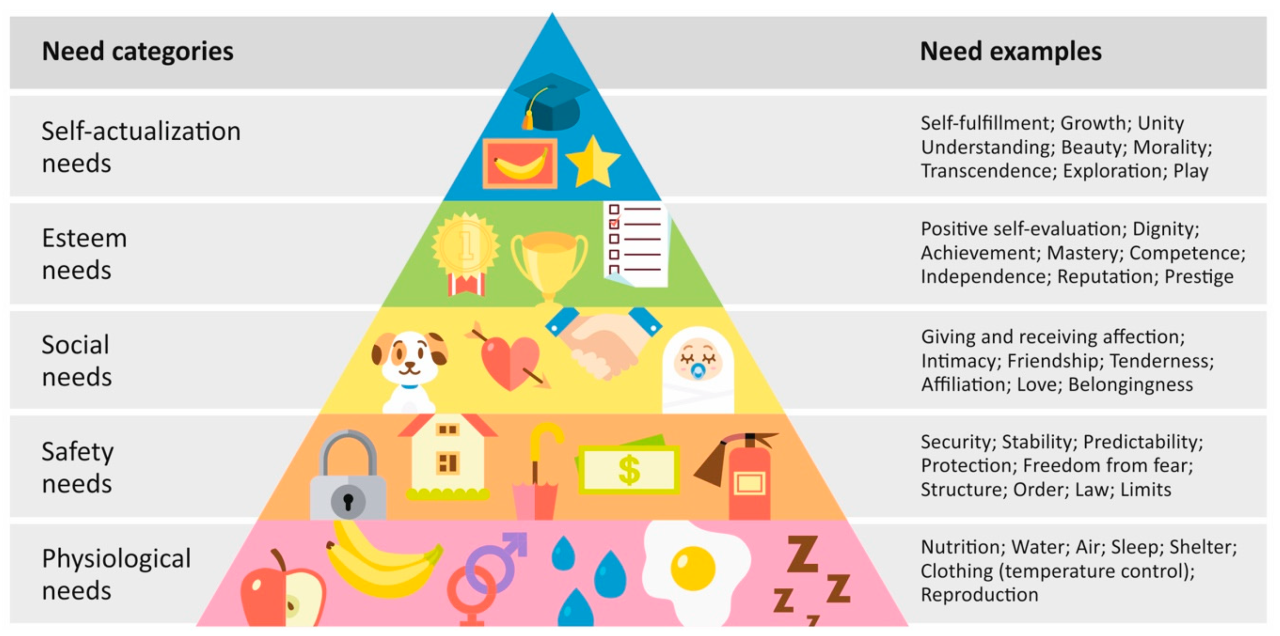Abraham Maslow’s Hierarchy of Needs is a fundamental theory that has revolutionized the way we understand human motivation. The theory of motivation states that five categories of human needs dictate an individual’s behavior. Those needs are physiological needs, safety needs, love and belonging needs, esteem needs, and self-actualization needs.
- Physiological needs are the most basic needs, such as food, water, shelter, and sleep.
- Safety needs include security, stability, and protection from harm.
- Love and belonging needs include the need for affection, intimacy, friendship, and a sense of connection.
- Esteem needs include the need for self-respect, the respect of others, and a sense of accomplishment.
- Self-actualization needs are the highest level of needs and include the need to achieve one’s full potential and to live a meaningful life.
Almost 80 years later, Maslow’s theory is still relevant because it provides a framework for understanding human motivation. It is a useful tool for managers who want to understand what motivates their employees and how to create a more positive and productive work environment.
Maslow’s theory proposes that people have a series of needs arranged in a pyramid, and they must fulfill lower-level needs before they can move on to higher-level needs. The five levels of Maslow’s hierarchy include physiological needs, safety needs, love and belonging needs, esteem needs, and self-actualization needs.
In the modern workforce, Maslow’s hierarchy of needs remains a crucial tool for employers to create a supportive and engaged workforce. By understanding employees’ needs and motivations, employers can create a work environment that satisfies these needs and drives employee engagement.
Physiological Needs
The first level of Maslow’s hierarchy of needs is physiological needs, which include basic needs for survival, such as food, water, shelter, and clothing. In the modern workforce, employers can meet employees’ physiological needs by providing adequate pay and benefits, including health insurance and paid time off. Additionally, employers must ensure a safe working environment and provide essential resources, such as clean water and air conditioning, to support employees’ physical well-being.
Safety Needs
Once employees’ physiological needs are met, they seek safety and security, including job security, financial stability, and a safe working environment. Employers can help meet these needs by providing fair compensation, job security, and a workplace free from harassment and discrimination.
Love and Belonging Needs
The third level of Maslow’s hierarchy of needs is love and belonging needs, which includes the need for social connection and a sense of belonging. In the modern workforce, employers can foster a sense of community by encouraging teamwork, providing opportunities for socializing and collaboration, and creating an inclusive work environment that values diversity and equity.
Esteem Needs
Once employees feel a sense of belonging, they seek respect and recognition from others and develop self-esteem. Employers can meet these needs by providing opportunities for growth and development, recognizing employees’ achievements, and giving employees autonomy in their work.
Self-Actualization Needs
The highest level of Maslow’s hierarchy of needs is self-actualization, where individuals seek to realize their full potential, pursue personal growth, and achieve their goals. In the modern workforce, employers can help employees achieve self-actualization by providing opportunities for meaningful work, supporting professional development and advancement, and encouraging creativity and innovation.
In the modern workforce, Maslow’s hierarchy of needs can help employers understand what motivates their employees and how to create a supportive work environment. For instance, if employees are struggling with physiological or safety needs, such as a lack of job security or poor working conditions, they may be less motivated to perform at their best. Employers can help address these needs by providing fair compensation, job security, and safe working conditions. As employees move up the hierarchy, employers can provide opportunities for growth and development, recognition, and meaningful work to help satisfy esteem and self-actualization needs. Ultimately, when employees feel fulfilled and motivated, they are more likely to be productive, engaged, and committed to the success of the organization. By understanding and addressing employees’ needs, employers can create a more engaged and productive workforce. Ultimately, when employees feel fulfilled and motivated, they are more likely to be productive, engaged, and committed to the success of the organization.

